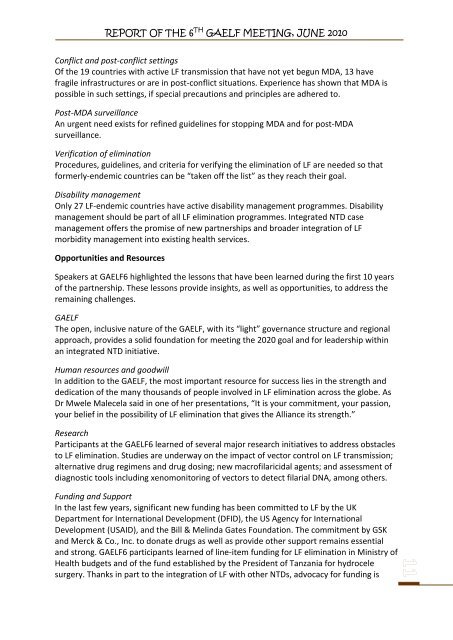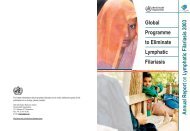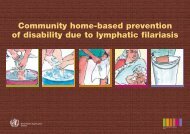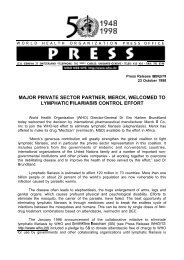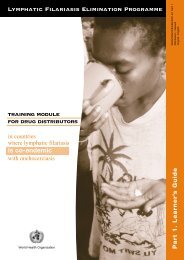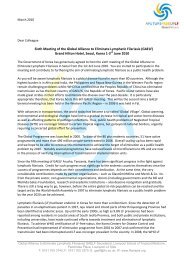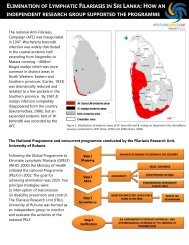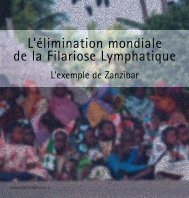English - Global Alliance to Eliminate Lymphatic Filariasis
English - Global Alliance to Eliminate Lymphatic Filariasis
English - Global Alliance to Eliminate Lymphatic Filariasis
Create successful ePaper yourself
Turn your PDF publications into a flip-book with our unique Google optimized e-Paper software.
REPORT OF THE 6 TH GAELF MEETING, JUNE 2010<br />
Conflict and post-conflict settings<br />
Of the 19 countries with active LF transmission that have not yet begun MDA, 13 have<br />
fragile infrastructures or are in post-conflict situations. Experience has shown that MDA is<br />
possible in such settings, if special precautions and principles are adhered <strong>to</strong>.<br />
Post-MDA surveillance<br />
An urgent need exists for refined guidelines for s<strong>to</strong>pping MDA and for post-MDA<br />
surveillance.<br />
Verification of elimination<br />
Procedures, guidelines, and criteria for verifying the elimination of LF are needed so that<br />
formerly-endemic countries can be “taken off the list” as they reach their goal.<br />
Disability management<br />
Only 27 LF-endemic countries have active disability management programmes. Disability<br />
management should be part of all LF elimination programmes. Integrated NTD case<br />
management offers the promise of new partnerships and broader integration of LF<br />
morbidity management in<strong>to</strong> existing health services.<br />
Opportunities and Resources<br />
Speakers at GAELF6 highlighted the lessons that have been learned during the first 10 years<br />
of the partnership. These lessons provide insights, as well as opportunities, <strong>to</strong> address the<br />
remaining challenges.<br />
GAELF<br />
The open, inclusive nature of the GAELF, with its “light” governance structure and regional<br />
approach, provides a solid foundation for meeting the 2020 goal and for leadership within<br />
an integrated NTD initiative.<br />
Human resources and goodwill<br />
In addition <strong>to</strong> the GAELF, the most important resource for success lies in the strength and<br />
dedication of the many thousands of people involved in LF elimination across the globe. As<br />
Dr Mwele Malecela said in one of her presentations, “It is your commitment, your passion,<br />
your belief in the possibility of LF elimination that gives the <strong>Alliance</strong> its strength.”<br />
Research<br />
Participants at the GAELF6 learned of several major research initiatives <strong>to</strong> address obstacles<br />
<strong>to</strong> LF elimination. Studies are underway on the impact of vec<strong>to</strong>r control on LF transmission;<br />
alternative drug regimens and drug dosing; new macrofilaricidal agents; and assessment of<br />
diagnostic <strong>to</strong>ols including xenomoni<strong>to</strong>ring of vec<strong>to</strong>rs <strong>to</strong> detect filarial DNA, among others.<br />
Funding and Support<br />
In the last few years, significant new funding has been committed <strong>to</strong> LF by the UK<br />
Department for International Development (DFID), the US Agency for International<br />
Development (USAID), and the Bill & Melinda Gates Foundation. The commitment by GSK<br />
and Merck & Co., Inc. <strong>to</strong> donate drugs as well as provide other support remains essential<br />
and strong. GAELF6 participants learned of line-item funding for LF elimination in Ministry of<br />
Health budgets and of the fund established by the President of Tanzania for hydrocele<br />
surgery. Thanks in part <strong>to</strong> the integration of LF with other NTDs, advocacy for funding is<br />
11


